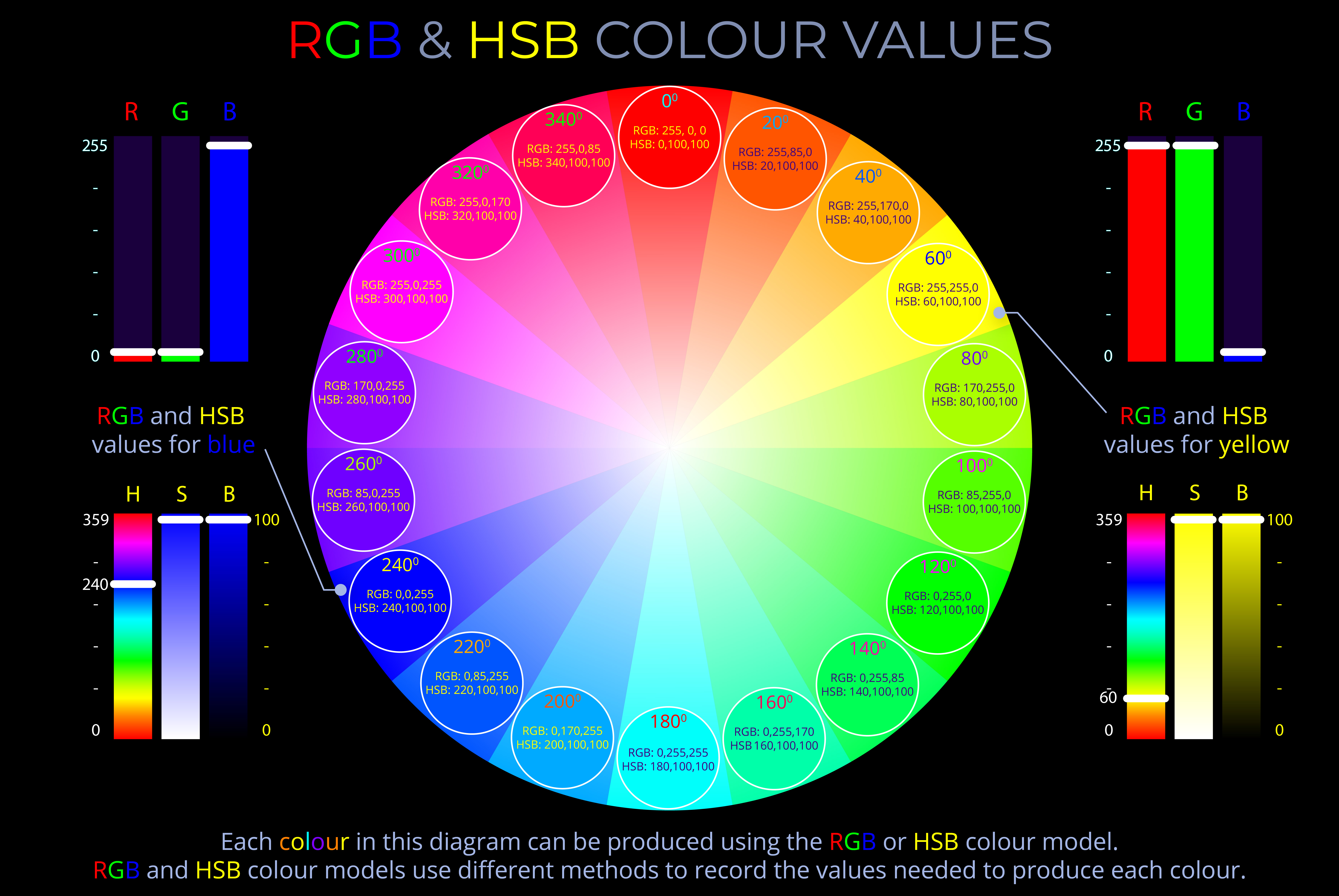RGB colour notation refers to the method used by the RGB colour model to identify and store colour values in a format recognizable to both computers and humans.
- RGB stands for red, green, and blue and is a commonly used colour model in digital imaging and computer graphics.
- The RGB colour model is an additive colour model, meaning that colours are created by adding different amounts of red, green, and blue light together.
- RGB colour notation is widely used in web design, graphic design, and other digital media.
RGB colour values are expressed as either:
-
- Decimal triplets. For example, the colour yellow is represented as 255, 255, 0.
- Hexadecimal triplets. For example, the colour green is represented as #00FF00.
- Computer software is usually programmed to recognize both decimal and hexadecimal forms of notation.
- Both decimal and hexadecimal notations represent the intensity of red, green, and blue used to create a specific colour.
RGB decimal notation
- An RGB decimal triplet is made up of three decimal numbers representing the intensities of the red, green, and blue components of a colour. Each component has a value between 0 and 255 and is separated by a comma.
- These are some familiar RGB decimal triplet:
- Red = 255, 0, 0
- Yellow = 255, 255, 0
- Green = 0, 255, 0
- Cyan = 0, 255, 255
- Blue = 0, 0, 255
- Magenta = 255, 0, 255
RGB hexadecimal notation
- RGB hexadecimal notation starts with a # sign.
- An RGB hexadecimal triplet is made up of three pairs of hexadecimal digits representing the intensities of the red, green, and blue components of a colour. Each pair has a value of 00 to FF and is written without spaces between. So red = 00 to FF, green = 00 to FF, blue = 00 to FF.
- Hexadecimal numbers count in base 16, and each digit represents a value from 0 to 15, where A-F represent 10 to 15.
- 00 to FF represents a sequence of 255 values.
- 0 to 15 appear as: 0, 1, 2, 3, 4, 5, 6, 7, 8, 9, A, B, C, D, E and F
- 16 to 31 appear as: 10, 11, 12, 13, 14, 15, 16, 17, 18, 19, 1A, 1B, 1C, 1D, 1E and 1F
- 32 to 47 appear as: 20, 21, 22, 23, 24, 25, 26, 27, 28, 29, 2A, 2B, 2C, 2D, 2E and 2F
- 48 to 63 appear as: 30, 31, 32, 33, 34, 35, 36, 37, 38, 39, 3A, 3B, 3C, 3D, 3E and 3F
- etc.
- 240 to 255 appear as: F0, F1, F2, F3, F4, F5, F6, F7, F8, F9, FA, FB, FC, FD, FE and FF
- Look carefully at the following examples that show matching hex and decimal values:
- Red = #FF0000 = 255, 00, 00
- Yellow = #FFFF00 = 255, 255, 0
- Green = #00FF00 = 0, 255, 0
- Cyan = #00FFFF = 0, 255, 255
- Blue = #0000FF = 0, 0, 255
- Magenta = #FF00FF = 255, 0, 255
References
- https://en.wikipedia.org/wiki/Comparison_of_color_models_in_computer_graphics
- https://en.wikipedia.org/wiki/Decimal
- https://en.wikipedia.org/wiki/Hexadecimal
- RGB colour notation refers to the method used by the RGB colour model to identify and store colour values in a format recognizable to both computers and humans.
- RGB stands for red, green, blue and is a commonly used colour model in digital imaging and computer graphics.
- The RGB colour model is an additive colour model, meaning that colours are created by adding different amounts of red, green, and blue light together.
- RGB colour notation is widely used in web design, graphic design, and other digital media.
- RGB colour values are expressed as either:
- Decimal triplets. For example, the colour yellow is represented as 255, 255, 0.
- Hexadecimal triplets. For example, the colour green is represented as #00FF00.



